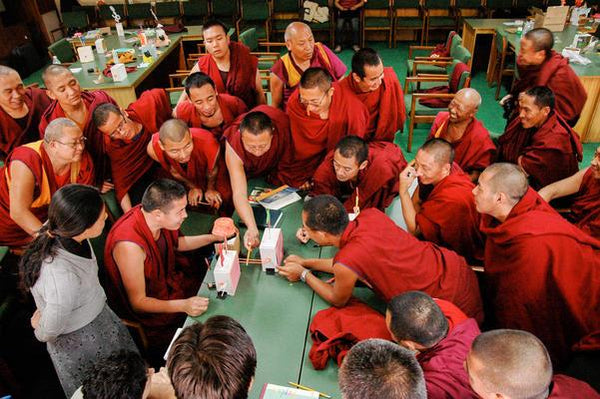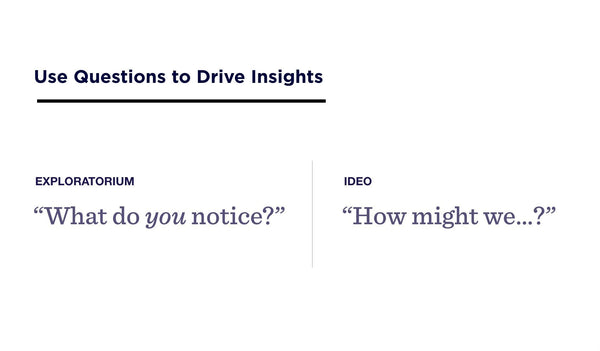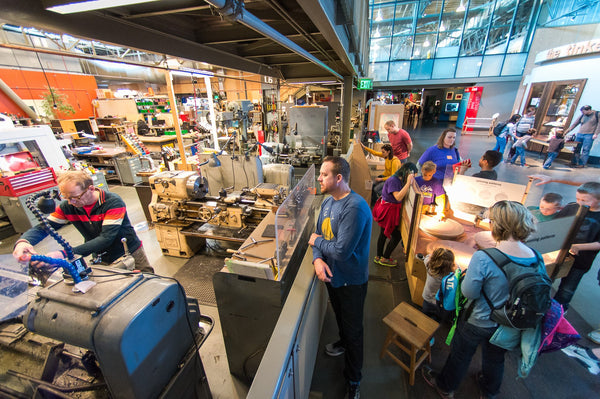In this episode of our Creative Confidence Series, Chris Flink, executive director of the Exploratorium, former IDEO partner, and a founding faculty member of Stanford University’s d.school talks to IDEO U Dean Suzanne Gibbs Howard about the evolution of the museum over 50 years, how they’ve expanded their reach globally, and how they cultivate creativity with their visitors, the broader community, and within their own organization.
What is a museum? That’s a question the Exploratorium has probed at—and invited its visitors to help answer—for 50 years. That said, “we very much favor the question over the answer,” says Chris Flink, executive director of the Exploratorium, an innovative science center that’s a fixture of the San Francisco Bay Area community.
Contrary to the image often conjured by the word “museum,” the Exploratorium is much more than a building housing a collection of images on view—it's an ongoing exploration of science, art and human perception—a vast collection of online and physical experiences designed to feed your curiosity.
“Today, eight in 10 science museums globally have Exploratorium-designed learning experiences, and the museum reaches 200 million people globally each year.”
As a partner at IDEO for 19 years and a founding member of Stanford University’s d.school, Chris brings a unique perspective to the museum—one that keeps humans at the center and uses design thinking to uncover new possibilities and find ways to expand the museum’s reach beyond their walls. Today, eight in 10 science museums globally have Exploratorium-designed learning experiences, and the museum reaches 200 million people globally each year.
We chatted with Chris to hear how the museum has evolved, ways they use design to create better experiences, and his thoughts on fostering a creative culture.

A Human-centered Approach To Learning
At the Exploratorium, visitor participation is core to the design of every experience. A machine shop in the middle of the gallery floor houses tools for building exhibit prototypes on site. Those prototypes are then taken out into the museum, teams observe how visitors engage with them, and those learnings educate the next round of iteration.
“That sort of back and forth between the shop floor and the museum floor, the interaction with the public and designing in dialogue with those users is a core piece of the innovation model,” Chris says.
“It’s okay to fail. It’s not okay to fail to learn from failure.”
Chris Flink
Inquiry-based learning is another essential piece of the Exploratorium’s approach. Rather than writing up plaques describing each exhibit and telling the visitor what it is they should take away, the staff at the museum can often be heard asking “What do you notice?” and prompting visitors to share their own interpretation of what is important or meaningful. Chris sees many similarities in the museum’s culture of questions to IDEO’s use of the “How might we…” question.
“You can often learn a lot about a creative culture by phraseology you hear frequently,” he says.
Beyond opening up the opportunity for co-creation, questions serve another purpose—“inviting people to see and connect the dots themselves and to gain the confidence that comes from successfully making sense of the world around you.”

Scaling Impact By Designing For Key Audiences
To retain focus and structure in an organization that is so creative—and hold the space for new possibilities at the same time—is a challenge for any organization. At the Exploratorium, they do this by focusing on three key areas of impact: inspiring visitors, empowering educators, and fueling a global movement. These areas center around three audiences that are critical to their mission.
The physical museum focuses on visitors and serves as a laboratory to prototype new ideas. To support educators, they’ve created professional development programs, fostered a vibrant community of educators, and developed many online resources and tools, like Science Snacks, that support state learning standards and can be used for free.
To bring their approach of experiential learning to others, they collaborate with other entities through the Global Studios program. By helping like-minded entities of all kinds create Exploratorium-like learning experiences, they reach millions more people each year. The team sees these global collaborations not only as a way to share out but to learn from their partners and improve their own museum experience.
Fostering a Creative Culture
To spark creativity and curiosity in others, Chris says it’s essential to maintain and support a culture of creativity within the organization as well. The Exploratorium faces challenges many creative companies can likely relate to—overcoming silos, learning from failure, and merging different cultures (academic, design, museum) into one organization. To work through these challenges, Chris uses a few tactics honed over his many years of design and business experience.
Staying human-centered is critical to maintaining motivation and inspiring new ideas. The Exploratorium ties their three key initiatives back to the audiences they serve, and the physical space at the museum also helps employees keep their audiences in mind. They often walk through the museum floor to get to meetings or work in the machine shop, seeing and engaging with visitors along the way.

Embracing failure as a learning moment is another important element of fostering their creative culture. “Seeing learning as a universally good thing for the individual and for the organization is something I believe in,” he says. While learning from failure is productive, Chris is careful not to welcome failure as an excuse to learn: “It’s okay to fail. It’s not okay to fail to learn from failure.” Working in an iterative, prototyping process enables failure to happen earlier on when the stakes are lower.
As a leader, Chris sees his role as thinking about “how to best position individuals to see opportunities to make connections that might not otherwise be obvious.”
“Creative leadership is not about having all the answers, but trying to frame an opportunity space and unleash your great people in it,” he says.
It’s also about leading teams through rounds of converging and diverging moments and giving clear direction so your team knows what is expected of them, and they’re on the same page about what part of the process you’re in. A creative leader signals when the team is moving from a brainstorming phase to a decision-making phase.
“There’s not just one way of being,” Chris says. “A good creative process of any kind has to shift gears at different points. The desired behaviors of your team members working in this collaborative way shifts as that unfolds.”
At the end of the day, being in such close quarters with the people they’re designing for is one of the most motivating factors for Chris.
“Being able to see the impact you’re having and the hard work you do actually unfolding around you is really nice.”
Want to learn more about fostering a creative culture and inspiring others? Check out our Leading for Creativity online course, part of the Foundations in Creative Leadership Certificate, to see a case study from the Exploratorium.
- choosing a selection results in a full page refresh
- press the space key then arrow keys to make a selection



